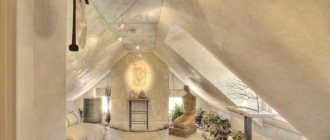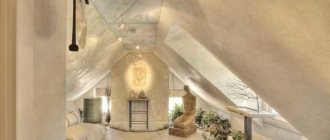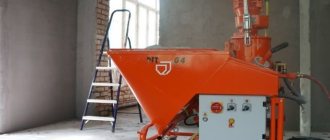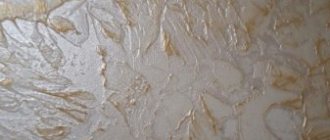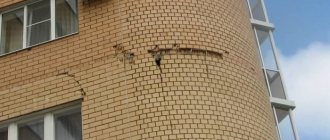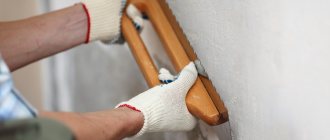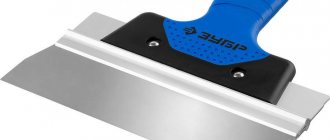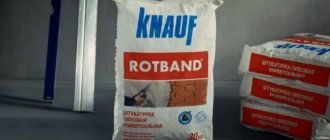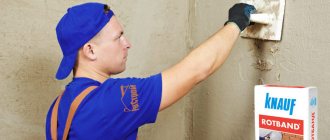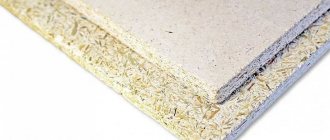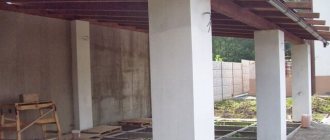Self-repair is not an easy task, but it is doable. Of course, there are a lot of subtleties in this matter and it is possible that you will not get perfectly smooth walls the first time. No problem: plaster is a malleable material, and with a few simple techniques, you can always level the walls exactly as needed.
Today we will talk about how to level walls with plaster with your own hands. Let's consider all the stages in order: selection of plaster, tools, preparation of plaster mortar, preparation of the wall surface, and, in fact, application of plaster. So, let's go.
Description of the tool
The term plastering rule itself means a tool that is used to correct defects and correct layers. But professionals use it for more diverse purposes. The tool may differ in size, as well as in the materials used in its production.
The term plastering rule itself means a tool that is used to correct defects and correct layers.
Best h-shaped building codes
Stayer h-profile 2 m
The two-meter rule is often purchased for finishing work. It is relevant in leveling both horizontal and vertical surfaces. On average, the price of the product is 1111 rubles.
For the manufacture of the “Stayer h-shaped profile 2 m” model, a lightweight material was used - aluminum alloy, which made it possible to achieve a low weight of the tool - 1.73 kg and its high strength. The unit is characterized by resistance to the occurrence of corrosion processes, as well as deformation and bending when damaged.
The special shape of the profile allows both the application of building mixtures and the removal of their excess. It is also responsible for additional structural rigidity. To prevent debris and other various mixtures from getting inside the housing, special half-packs made of durable plastic are installed on the sides of the device.
Stayer h-profile 2 m
Advantages:
- Durability;
- Affordable price;
- Ease of use;
- Optimal dimensions – 250x3x11.5 cm;
- The products comply with the standards and requirements of GOST;
- High strength.
Flaws:
- Not detected.
Gigant ALRH25
The construction rule is characterized by high resistance to mechanical and corrosion damage due to the fact that durable and wear-resistant aluminum was used for its manufacture. Good structural rigidity ensures a secure grip and maximum ease of use even over long periods of time.
Gigant ALRH25 is designed for processing cement-sand mixture when installing screed or pouring floors. Convenient shape, light weight (2.03 kg) and optimal dimensions (250x11.5x3 cm) of the model allow you to quickly cope with surfaces of both large and small areas. On average, the cost of this product is 1030 rubles.
Gigant ALRH25
Advantages:
- Long service life;
- High-quality assembly;
- Easy to use;
- Reliable grip;
- Efficiency.
Flaws:
- Not detected.
Stabila H.A.K.
The professional H-shaped tool is designed for finishing work on finishing materials such as plaster and plaster. Thanks to the presence of a grip, the profile fits comfortably in the hand, which contributes to high comfort during operation.
Stabila HAK has an optimal cross-section - 2.7x11.2 cm, weight - 1.11 kg and length - 1500 mm. Durable aluminum was used to produce the model, which made it possible to achieve high resistance to corrosion and possible deformation. The average price of a product is 1,702 rubles.
Stabila H.A.K.
Advantages:
- High quality (made in Germany);
- Affordable price;
- Wear resistance;
- Effective work;
- Ease of use.
Flaws:
- Short warranty period - 2 months.
Scope of application
In addition to its direct purpose in the form of surface leveling, a number of other applications can be identified that will be useful during construction work:
- Assessment of the correct geometric shape of a building or position in space;
- Obtaining an even layer of plaster layer, screed;
- Making beacons from mixtures;
- Drawing straight lines;
- To securely support the glass cutter while it is working.
In addition to its direct purpose in the form of surface leveling, a number of other applications can be identified that will be useful during construction work.
Preparing surfaces for leveling
The main methods of leveling and determining the curvature of a surface have already been described above, but preparation must be carried out before starting work.
The importance of preparatory work can hardly be overestimated - preparation has such a strong impact on the quality of the entire finishing complex. Work on leveling the walls begins with the removal of decorative finishing (wallpaper, cladding, layers of paint or whitewash). The freed surface is examined visually and using a simple instrument. Detection of defects in the plaster layer.
Removing old coating
Having identified the nature of the deviations, they begin the initial correction. If the plaster coating is strong and has no defects, then excessively large protrusions or protrusions are cut down. If there are many defects and the coating is considered unsuitable, it is removed to the base.
Wall structures can be made of brick, monolithic or prefabricated reinforced concrete, wood, or made of stone or cellular concrete blocks. The type of wall material determines part of the preparatory work that increases adhesion strength. For example, stone or brick masonry requires jointing (0.5-1.0 cm deepening), concrete surfaces require notching to ensure strong adhesion of the mortar to smooth concrete.
Notching
Wooden surfaces are filled with shingles or wire mesh is attached. Measures to increase adhesion cannot be neglected, since plastering creates a coating that has a large dead weight.
Preparatory measures also include cleaning the base from stains of various kinds. Oil stains must be degreased. Rot, fungus, and mold are scraped out, washed and treated with an antibiotic agent.
Removing stains
Efflorescence, rust, and soot are removed in different ways. To prevent new rust from appearing, all unnecessary metal parts are removed from the wall, and the remaining ones are insulated, for example, with oil paint. To prevent efflorescence, high-quality waterproofing of walls is done.
During internal work, hidden wiring is de-energized. At the same time, sockets and switches are often replaced, that is, old covers are removed, the ends of the wires are insulated, and the boxes are sealed with masking tape while plastering. After all finishing work is completed, new electrical appliances are installed.
Cracks, chips and other defects in the foundation are repaired. The surface of the base is cleaned of dust. Apply a primer that matches both the wall material and the plaster mortar. Preparatory work also includes reinforcement and installation of beacons. The base must not only be cleaned, but also dried.
Sealing cracks
Preparatory work step by step:
- removal of old coating;
- cleaning the base;
- repair of defects;
- applying a primer;
- drying;
- reinforcement;
- installation of beacons.
Features of use
The nuances of applying the painting rule depend on the chosen task. It is also important to consider the size of the tool here. There are options that help create smooth corner areas.
It can be noted that if the edge is made of steel rather than aluminum, then it will work longer and be more durable. And it is usually chosen by professionals.
If the edge is made of steel rather than aluminum, then it will work longer and be more durable.
Why does the price of plastering walls without beacons cost less than 250 rubles per m2?
In today's construction market there are a lot of offers for plastering and painting work from visiting residents of the CIS to private teams. Naturally, everyone wants to save money and choose those who are cheaper. But let's understand everything thoroughly. Is it worth saving on plastering work done by private owners or teams? Having called one such advertisement, I was informed that the cost of plastering a 2-room apartment with an area of 60 square meters would be 200 rubles per m2 of surface, and the material consumption would be 15-20 Knauf Rotband bags.
Varieties
Typically, tools for plastering work come in different shapes. To understand what the difference is between the types, and why it is better to choose converted options, you should study the features of each.
Typically, tools for plastering work come in different shapes.
H shaped rule
The plastering rule is a lightweight type, so it can be used to treat large areas. It does not put increased stress on the hands; a specialist will feel comfortable using the rule after he has plastered the surface; it is suitable for gypsum plasters of the Rotband type. But its low weight also does not allow the tool to be used for thick layers of plaster mixture.
The plastering rule is a lightweight type, so it can be used to treat large areas.
Trapezoid
This option is suitable for working with heavy solutions; thanks to its shape and the material used in production, it allows you to level long sections at once. Only in this case the simultaneous work of two masters is required.
This option is suitable for working with heavy solutions.
Rectangular
In terms of form, this is the simplest option. Not suitable for leveling walls as a rule; it is usually used when it comes to concrete screed. It is uncomfortable to control the surface with light.
There are options where a level is also included, but keep in mind that the bubble level often breaks. After all, increased loads are usually applied.
Not suitable for leveling walls as a rule; it is usually used when it comes to concrete screed.
Serrated
This is a subtype of the h-shaped tool. It is used for only one purpose, to apply adhesive plaster solutions. It is also noted that it works only with light mixtures.
It works only with light mixtures.
Angular
This is a highly specialized type; it is required when the corner sections of the wall are aligned; it is easier to get a 90-degree angle with it. For this reason, it cannot be adapted for other purposes after plastering.
It is required when the corner sections of the wall are leveled; it is easier to obtain a 90-degree angle with it.
The finishing layer of plaster is a covering.
After the inserts have dried, the wall is leveled in such a way as to cover all small scratches and small tool marks. To do this, prepare a liquid, creamy solution on fine sand, sifted through a 1.5x1.5mm sieve.
The sprayed covering is leveled with a wide spatula or trowel and carefully leveled, often wetting the tool.
The almost dry layer is “sanded” with a felt grater.
Such a wall becomes perfectly flat. data-matched-content-ui-type=”image_stacked” data-matched-content-rows-num=”2″ data-matched-content-columns-num=”3″ data-ad-format=”autorelaxed”>
What to look for when choosing a product
It is difficult for beginners to understand which tool is best to choose for doing plastering with their own hands. Therefore, you should figure out what criteria are important; this will be discussed below.
It is difficult for beginners to understand which tool is best to choose for doing plastering with their own hands.
Profile form
To understand which form will be suitable, you should study the features of each. They were discussed in the previous chapter. We can say that the trapezoidal look is more universal.
The trapezoidal look is more versatile.
Presence of stiffeners
Stiffening ribs make it easier to align, because when the rule is moved to remove excess mortar, they create forces, and in order for the tool to withstand such loads, additional reinforcements are needed. You can find out whether the rule has stiffening ribs if it has rubber plugs along the edges.
Stiffening ribs make the alignment process easier.
Correct geometry
To make accurate alignments, the slats need to be perfectly straight. The check is carried out as follows: on a flat surface, using an edge, draw a straight line, then turn the rod, placing it on the other side of the line, and again draw a horizontal strip. If the stripes match, then the instrument is good; if not, then you cannot purchase it.
To make accurate alignments, the slats need to be perfectly straight.
Material of manufacture
Previously, wood rules were used, but the short service life of these types was considered a disadvantage. Aluminum types are more practical. You can also find options with steel edges on sale, but they will be more expensive. A sharp edge is necessary for interior decoration; a rounded edge is suitable for facade decoration.
Aluminum types are more practical.
Product dimensions
Plastering will usually be carried out on different areas. And the sizes of the tools are different, it is better for a beginner to choose short types, otherwise it will be difficult to cope with the work. The longest are the three-meter rules; they are applicable only when the work is carried out by two masters.
It is better for a beginner to choose short types, otherwise it will be difficult to cope with the work.
Availability of level
The level allows you to simply control the evenness of the surface. However, there is a possibility that during increased movement the readings will be off; you should periodically check the correctness of the bubble measuring device.
The level allows you to simply control the evenness of the surface.
Material
- aluminum - modern and high-quality tools are made of light metal. They are light in weight, which is important for large volumes of work. But aluminum does not provide durability, and when working with plaster (especially with cement-sand mortars), the edge of the rule wears out over time. It develops unevenness and scratches that impair the quality of plastering;
- Steel edge stays straight longer
aluminum with a steel working edge - a rule, the working part of which is reinforced with a steel strip. It has all the advantages of an aluminum product. The special design prevents the possibility of tool bending; high-quality steel of the working edge extends the service life of the rule several times compared to the previous version. The main disadvantage is the high price of products made from combined materials;
- wood is a cheap, disposable option. For work, slats with a smooth, polished edge are used. An obvious advantage is the possibility of making a wooden rule from available material. Increased hygroscopicity and a tendency to swelling and warping are disadvantages that cannot be corrected, even by thoroughly drying the product after the work.
How to work as a rule
Plastering walls can usually be done using beacons, which make the work easier, but sometimes they decide not to use them. You need to figure out how to proceed in both cases.
Plastering walls can usually be done using beacons, which make the work easier.
Working as a rule for beacons
Set the rule exactly along the beacons, and begin to slowly move along the applied primer layer. It is necessary to remove excess mixture in time, after which it must be moistened with water to avoid mixture residues.
The tool is pressed, but should not be pressed in.
Set the rule exactly along the beacons, and begin to slowly move along the applied primer layer.
Working as a rule without beacons
If it is decided to save money and eliminate the use of beacons, and there are no strong demands on the quality of the surface, then the method can be chosen. In this case, the tool should be equal to the length from the ceiling to the floor; it is moved along the mortar along the wall. Afterwards the surface is leveled with a spatula.
The tool should be equal in length from the ceiling to the floor; it is used to move along the mortar along the wall.
Dimensions
Tools are available in various sizes. The ease of use of the rule is affected by its length, which must be selected depending on the width of the wall and the distance between the guide beacons.
The rule should lie on two beacons and extend beyond them by 10-20 cm. This is necessary so that when leveling the plaster, pull the tool not only up, but also left and right.
Manufacturers offer a standard size range of finished products from 1 to 3 meters in increments of 50 cm.
Long rules are convenient to use when working in pairs, which speeds up the process of plastering the wall. The largest tool is used to check the diagonal of the plastered wall and reveal hidden defects.
Any plastering tool can be made truncated, i.e. cut in the right place to fit the width of the wall.
As a rule, check the evenness of the wall
You can easily analyze the evenness of the base. The tool is placed with the sharp side to the surface; if there are any defects, the rail will wobble. Or, in the light, it will be noticeable that the edges of the device are hanging. The flowing areas will also be visible in the light.
You can easily analyze the evenness of the base.
The rule facilitates the process of plastering the surface; if the work is one-time, then there is no point in buying expensive steel variations or highly specialized types. In such a case, you can resort to making the tool yourself.
Rectangular Shape Rule
To carry out installation work, professional craftsmen prefer to use several forms of metal strips. Some models have a large flask with liquid.
It allows you to control the level of inclination on the plane.
- A distinctive feature of the rectangular building rule is considered to be high rigidity.
- They prefer to choose such products for decorating a concrete floor screed or evenly distributing a thick mortar on a vertical surface.
- For novice craftsmen, this form of tool will seem inconvenient.
- The fact is that wide ribs make it difficult to control the level of inclination on the surface.
- An acute angle is unable to remove a large volume of excess building composition.
When using the rectangular rule with a capsule, it is important to consider that in order to correctly determine the angle, it is necessary to adjust the structure.
During the operation of the product, violations of the indicators are observed. With the correct positioning of the tool, it is possible to achieve a level base.
Which rule should you choose?
Which rule is best to purchase largely depends on its features:
- To perform external and internal work, the “STAYER Master 10723” model is relevant.
- The ideal option for processing horizontal and vertical sections is “Sibrteh 89607” or “ZUBR 10721”.
- If you plan to process various types of solution, then you should pay attention to “JETTOOLS 2.5 m”.
- For areas of any size, purchasing “Kraftool 10735-1.5” is relevant.
- “Matrix 89639” will help to correct the deviation of the plane from the verticals and horizontals.
- If versatility is a priority, then you need to pay attention to “SANTOOL 020621”.
- For those who want to purchase a long device, the best solution would be to purchase “ZUBR 10751”.
- STAYER Professional 10752 is characterized by high measurement accuracy.
- The “Stayer h-profile 2 m” is characterized by excellent value for money.
- Gigant ALRH25 and Stabila HAK can handle work of any complexity.
- If you are looking for a spatula and a rule in one, then “Melody of Color, 600 mm, stainless steel 0.3 mm ShP03-600” is the ideal option.
A correctly chosen rule will be an excellent assistant in construction and repair work. The rating presented the most versatile, functional, reliable and durable devices that can be ordered online through the Yandex Market Internet platform.
The best construction trowel rules
Melody of color, 600 mm, stainless steel 0.3mm ShP03-600
The stainless steel rule spatula is designed to prepare surfaces for subsequent finishing by eliminating defects and irregularities. When distributing plaster, the product works together with beacons. For maximum comfort when processing areas, the manufacturer has provided an ergonomic holder made of aluminum.
The popularity of this model is due to the possibility of replacing the canvas (a part of the same brand will do), which significantly affects the duration of the operational period. The blade of the unit must also be replaced. Moreover, the installation of blades of various thicknesses is supported. To allow smooth application of the material, they have rounded edges. The average price of the product is 2346 rubles.
Melody of color, 600 mm, stainless steel 0.3mm ShP03-600
Advantages:
- Light weight – 0.8 kg;
- Optimal dimensions – 150x600x60 mm;
- High quality;
- Affordable price;
- Long operational period.
Flaws:
- Not detected.
